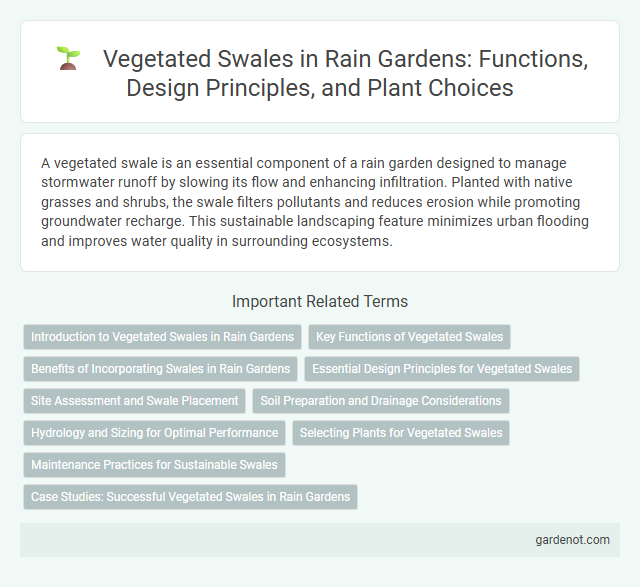A vegetated swale is an essential component of a rain garden designed to manage stormwater runoff by slowing its flow and enhancing infiltration. Planted with native grasses and shrubs, the swale filters pollutants and reduces erosion while promoting groundwater recharge. This sustainable landscaping feature minimizes urban flooding and improves water quality in surrounding ecosystems.
Introduction to Vegetated Swales in Rain Gardens
Vegetated swales are shallow, planted channels designed to slow and filter stormwater runoff in rain gardens. These natural drainage systems enhance infiltration and remove pollutants through vegetation and soil media, improving water quality. Their strategic placement along slopes or parking lots helps manage runoff volume while supporting native plant growth and habitat creation.
Key Functions of Vegetated Swales
Vegetated swales play a crucial role in managing stormwater by slowing runoff and facilitating infiltration into the soil, which reduces surface water flow and minimizes erosion. These landscaped channels filter pollutants through vegetation and soil media, improving water quality before it enters natural waterways or groundwater. Their capacity to support diverse plant species also enhances habitat value and promotes urban biodiversity.
Benefits of Incorporating Swales in Rain Gardens
Vegetated swales enhance rain gardens by effectively managing stormwater runoff, reducing erosion, and improving water quality through natural filtration. These swales increase groundwater recharge by slowing water flow and promoting infiltration, which supports local ecosystems and plant health. Incorporating swales also minimizes urban flooding and decreases pollutant loads entering nearby water bodies, making them essential for sustainable stormwater management.
Essential Design Principles for Vegetated Swales
Vegetated swales require proper slope design, typically between 1% and 5%, to ensure effective stormwater conveyance without causing erosion. Incorporating dense, deep-rooted native plants stabilizes soil, enhances water infiltration, and filters pollutants. Adequate swale dimensions, including width and depth tailored to expected runoff volumes, optimize hydraulic performance and habitat value.
Site Assessment and Swale Placement
Vegetated swale placement requires a thorough site assessment to evaluate soil permeability, slope gradient, and existing drainage patterns for optimal water flow management. Selecting locations with well-drained soils and gentle slopes between 1% to 5% ensures effective infiltration and reduces erosion risks. Proper site analysis minimizes flooding and enhances pollutant removal by positioning the swale to intercept and treat stormwater runoff efficiently.
Soil Preparation and Drainage Considerations
Vegetated swales require well-prepared soil that balances permeability and nutrient retention to support optimal plant growth and efficient water infiltration. Proper soil amendment with organic matter enhances structure and increases drainage capacity, preventing waterlogging and promoting pollutant filtration. Drainage considerations include creating a gentle slope to facilitate controlled runoff and incorporating underdrains or gravel layers to manage excess water during heavy rainfall events.
Hydrology and Sizing for Optimal Performance
Vegetated swales effectively manage stormwater by slowing runoff, promoting infiltration, and reducing peak flow rates, which mitigates flooding and improves water quality. Hydrologic design parameters such as catchment area, soil permeability, and rainfall intensity determine swale dimensions, typically requiring a length-to-width ratio of 4:1 or greater and an average depth of 0.3 to 0.6 meters for optimal infiltration. Proper sizing ensures that swales can handle the water volume from a design storm event, preventing overflow and enabling pollutant removal through sedimentation and plant uptake.
Selecting Plants for Vegetated Swales
Selecting plants for vegetated swales involves choosing native species with deep root systems to enhance water infiltration and stabilize soil. Grasses, sedges, and rushes that tolerate periodic flooding and drought conditions improve swale functionality and resilience. Incorporating diverse plant species supports habitat creation, pollutant removal, and aesthetic appeal while reducing maintenance requirements.
Maintenance Practices for Sustainable Swales
Vegetated swale maintenance involves regular inspection to ensure proper vegetation health, sediment removal, and debris clearance to maintain optimal water infiltration and flow. Native plants are preferred due to their deep root systems that enhance soil stability and pollutant filtration, requiring minimal irrigation and fertilization. Seasonal pruning and periodic regrading prevent erosion and support the swale's long-term functionality in sustainable stormwater management.
Case Studies: Successful Vegetated Swales in Rain Gardens
Vegetated swales in rain gardens have demonstrated effective stormwater management by reducing runoff and improving water quality in urban settings. A study of Seattle's Thornton Creek watershed revealed that swales planted with native vegetation decreased peak flow rates by 30%, highlighting their role in flood mitigation. Similarly, Portland's Tryon Creek Watershed utilized vegetated swales to enhance infiltration, achieving a 25% reduction in pollutant loads, illustrating their environmental benefits.
Vegetated swale Infographic

 gardenot.com
gardenot.com